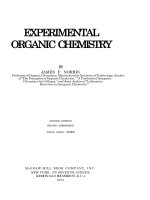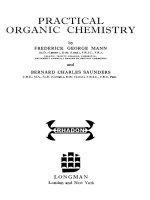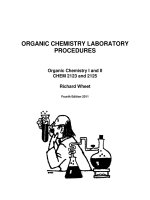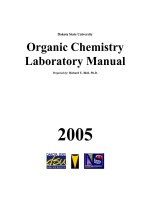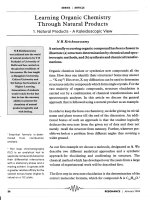Advanced practical organic chemistry
Bạn đang xem bản rút gọn của tài liệu. Xem và tải ngay bản đầy đủ của tài liệu tại đây (2.97 MB, 301 trang )
First Edition, 2009
ISBN 978 93 80168 81 4
© All rights reserved.
Published by:
Global Media
1819, Bhagirath Palace,
Chandni Chowk, Delhi-110 006
Email:
Table of Contents
1. Introduction
2. Functional Groups
3. Organic Synthesis Reagents
4. The Structure
5. Reactions of Organic Names
6. Different Elements
7. Process of Reaction
8. Process of Oxidation and Reduction
9. Reaction and Mechanism
1
Advanced Practical Organic Chemistry
1
IntroductionIntroduction
IntroductionIntroduction
Introduction
Organic chemistry is the branch of chemistry in which
covalent carbon compounds and their reactions are studied.
A wide variety of classes of compounds such as vitamins,
drugs, natural and synthetic fibres, as well as carbohydrates,
peptides, and fats consist of organic molecules. Organic
chemists determine the structures of organic molecules, study
their various reactions, and develop procedures for the synthesis
of organic substances.
Organic chemistry is the study of the properties of the
compounds of carbon that are organic. All carbon compounds
except for a few inorganic carbon compounds are organic.
Inorganic carbon compounds include the oxides of carbon, the
bicarbonates and carbonates of metal ions, the metal cyanides,
and a few others.
Organic chemistry is the most important branch of
chemistry — but of course it would be nothing without the
many other areas of chemistry — in fact all branches of
chemistry should not be viewed in isolation, even though they
may often be taught in isolation.
2
Advanced Practical Organic Chemistry
Organic chemistry is all around us, life is based on organic
chemistry, the clothes we wear, the drugs we take, the cars we
drive and the fuel that propels them, wood, paper, plastics and
paints.
Organic chemistry is the study of compounds containing
carbon the ability of carbon to form as many as 4 strong bonds
to many other atoms, e.g., carbon, hydrogen, oxygen, nitrogen,
halogens, sulphur, phosphorus ensures a virtual infinite number
of possible compounds the constituent atoms and their exact
combination determines the chemical and physical properties
of compounds and hence, their suitability for applications.
To understand life as we know it, we must first understand
a little bit of organic chemistry. Organic molecules contain
both carbon and hydrogen. Though many organic chemicals
also contain other elements, it is the carbon-hydrogen bond
that defines them as organic. Organic chemistry defines life.
Just as there are millions of different types of living organisms
on this planet, there are millions of different organic molecules,
each with different chemical and physical properties. There
are organic chemicals that make up your hair, your skin, your
fingernails, and so on. The diversity of organic chemicals is
due to the versatility of the carbon atom. Why is carbon such
a special element? Let’s look at its chemistry in a little more
detail.
Carbon (C) appears in the second row of the periodic table
and has four bonding electrons in its valence shell. Similar to
other non-metals, carbon needs eight electrons to satisfy its
valence shell. Carbon, therefore, forms four bonds with other
atoms (each bond consisting of one of carbon’s electrons and
one of the bonding atom’s electrons). Every valence electron
participates in bonding, thus a carbon atom’s bonds will be
distributed evenly over the atom’s surface. These bonds form
a tetrahedron (a pyramid with a spike at the top), as illustrated
3
Advanced Practical Organic Chemistry
below:
Carbon forms 4 bonds
Organic chemicals gets their diversity from many different
ways carbon can bond to other atoms. The simplest organic
chemicals, called hydrocarbons, contain only carbon and
hydrogen atoms; the simplest hydrocarbon (called methane)
contains a single carbon atom bonded to four hydrogen atoms:
Methane:
A carbon atom bonded to 4 hydrogen atoms
But carbon can bond to other carbon atoms in addition to
hydrogen, as illustrated in the molecule ethane below:
Ethane:
A carbon-carbon bond
In fact, the uniqueness of carbon comes from the fact that
it can bond to itself in many different ways. Carbon atoms can
form long chains:
4
Advanced Practical Organic Chemistry
Hexane:
A 6-carbon chain
Branched ChainsBranched Chains
Branched ChainsBranched Chains
Branched Chains
Isohexane:
A branched-carbon chain
RingsRings
RingsRings
Rings
Cyclohexane:
A ringed hydrocarbon
They appears to be almost no limit to the number of different
structures that carbon can form. To add to the complexity of
organic chemistry, neighbouring carbon atoms can form double
5
Advanced Practical Organic Chemistry
and triple bonds in addition to single carbon-carbon bonds:
Single bonding Double bonding Triple bonding
Keep in mind that each carbon atom forms four bonds. As
the number of bonds between any two carbon atoms increases,
the number of hydrogen atoms in the molecule decreases (as
can be seen in the figures above).
Simple HydrocarbonsSimple Hydrocarbons
Simple HydrocarbonsSimple Hydrocarbons
Simple Hydrocarbons
The simplest hydrocarbons are those that contain only
carbon and hydrogen. These simple hydrocarbons come in
three varieties depending on the type of carbon-carbon bonds
that occur in the molecule. Alkanes are the first class of simple
hydrocarbons and contain only carbon-carbon single bonds.
The alkanes are named by combining a prefix that describes
the number of carbon atoms in the molecule with the root
ending “ane”. The names and prefixes for the first ten alkanes
are given in the following table:
CarbonCarbon
CarbonCarbon
Carbon
PrefixPrefix
PrefixPrefix
Prefix
AlkaneAlkane
AlkaneAlkane
Alkane
ChemicalChemical
ChemicalChemical
Chemical
StructuralStructural
StructuralStructural
Structural
AtomsAtoms
AtomsAtoms
Atoms
NameName
NameName
Name
FormulaFormula
FormulaFormula
Formula
FormulaFormula
FormulaFormula
Formula
1 Meth- Methane CH
4
CH
4
2 Eth- Ethane C
2
H
6
CH
3
CH
3
3 Prop- Propane C
3
H
8
CH
3
CH
2
CH
3
4 But- Butane C
4
H
10
CH
3
CH
2
CH
2
CH
3
5 Pent- Pentane C
5
H
12
CH
3
CH
2
CH
2
CH
2
CH
3
6 Hex- Hexane C
6
H
14
CH
3
CH
2
CH
2
CH
2
CH
2
CH
3
7 Hept- Heptane C
7
H
16
CH
3
CH
2
CH
2
CH
2
CH
2
CH
2
CH
3
8 Oct- Octane C
8
H
18
CH
3
CH
2
CH
2
CH
2
CH
2
CH
2
CH
2
CH
3
6
Advanced Practical Organic Chemistry
9 Non- Nonane C
9
H
20
CH
3
CH
2
CH
2
CH
2
CH
2
CH
2
CH
2
CH
2
CH
3
10 Dec- Decane C
10
H
22
CH
3
CH
2
CH
2
CH
2
CH
2
CH
2
CH
2
CH
2
CH
2
CH
3
The chemical formula for any alkane is given by the
expression C
n
H
2n+2
. The structural formula, shown for the first
five alkanes in the table, shows each carbon atom and the
elements that are attached to it. This structural formula is
important when we begin to discuss more complex
hydrocarbons. The simple alkanes share many properties in
common. All enter into combustion reactions with oxygen to
produce carbon dioxide and water vapour. In other words,
many alkanes are flammable. This makes them good fuels. For
example, methane is the principle component of natural gas,
and butane is common lighter fluid.
CH
4
+ 2O
2
→ CO
2
+ 2H
2
O
The combustion of methane
The second class of simple hydrocarbons, the alkenes,
consists of molecules that contain at least one double-bonded
carbon pair. Alkenes follow the same naming convention used
for alkanes. A prefix (to describe the number of carbon atoms)
is combined with the ending “ene” to denote an alkene. Ethene,
for example is the two-carbon molecule that contains one double
bond. The chemical formula for the simple alkenes follows the
expression C
n
H
2n
. Because one of the carbon pairs is double
bonded, simple alkenes have two fewer hydrogen atoms than
alkanes.
Ethene
Alkynes are the third class of simple hydrocarbons and are
molecules that contain at least one triple-bonded carbon pair.
Like the alkanes and alkenes, alkynes are named by combining
7
Advanced Practical Organic Chemistry
a prefix with the ending “yne” to denote the triple bond. The
chemical formula for the simple alkynes follows the expression
C
n
H
2n-2
.
Ethyne
IsomersIsomers
IsomersIsomers
Isomers
Because carbon can bond in so many different ways, a
single molecule can have different bonding configurations.
Consider the two molecules illustrated here:
C
6
H
14
CH
3
CH
2
CH
2
CH
2
CH
2
CH
3
CH
3
|
C
6
H
14
CH
3
CH
2
CH
2
CH
2
CH
3
Both molecules have identical chemical formulas; however,
their structural formulas (and thus some chemical properties)
are different. These two molecules are called
isomers
. Isomers
are molecules that have the same chemical formula but different
structural formulas.
8
Advanced Practical Organic Chemistry
FF
FF
F
unctional Groupsunctional Groups
unctional Groupsunctional Groups
unctional Groups
In addition to carbon and hydrogen, hydrocarbons can
also contain other elements. In fact, many common groups of
atoms can occur within organic molecules, these groups of
atoms are called
functional groups
. One good example is the
hydroxyl functional group. The hydroxyl group consists of a
single oxygen atom bound to a single hydrogen atom (-OH).
The group of hydrocarbons that contain a hydroxyl functional
group is called
alcohols
. The alcohols are named in a similar
fashion to the simple hydrocarbons, a prefix is attached to a
root ending (in this case “anol”) that designates the alcohol.
The existence of the functional group completely changes the
chemical properties of the molecule. Ethane, the two-carbon
alkane, is a gas at room temperature; ethanol, the two-carbon
alcohol, is a liquid.
Ethanol
Ethanol, common drinking alcohol, is the active ingredient
in “alcoholic” beverages such as beer and wine.
MoleculesMolecules
MoleculesMolecules
Molecules
All substances are made up of molecules which are
collections of atoms. All the molecules in existence are made
up of about a hundred different kinds of atoms.
For example, a water molecule is composed of two atoms
of hydrogen and one atom of oxygen. We write its formula as
H
2
O.
A molecule of sulphuric acid contains two atoms of
9
Advanced Practical Organic Chemistry
hydrogen, one atom of sulphur and four atoms of oxygen. Its
formula is H
2
SO
4
.
These are simple molecules containing only a few atoms.
Most inorganic molecules are small. Below are a few common
inorganic substances with their formulas:
Name of SubstanceName of Substance
Name of SubstanceName of Substance
Name of Substance
FormulaFormula
FormulaFormula
Formula
Carbon Dioxide CO
2
Salt NaCl
Nitric Acid HNO
3
Laughing Gas N
2
O
Ammonia NH
3
Saltpetre (used in gunpowder) KNO
3
Carbon Monoxide CO
Potassium Permanganate (used in labs) KMnO
4
Calcium Carbonate (chalk) CaCO
3
All of these molecules have less than a dozen atoms.
The symbols Ca, K, Mn, Na and Cl stand for calcium,
potassium, manganese, sodium and chlorine, respectively.
Molecules with Carbon
Most atoms are only capable of forming small molecules.
However, one or two can form larger molecules.
By far and away the best atom for making large molecules
with, is carbon. Carbon can make molecules that have tens,
hundreds, thousands even millions of atoms. The huge number
of possible combinations means that there are more carbon
compounds that those of all the other elements put together.
A single carbon atom is capable of combining with up to
10
Advanced Practical Organic Chemistry
four other atoms. We say it has a valency of 4. Sometimes a
carbon atom will combine with fewer atoms.
The carbon atom is one of the few that will combine with
itself.
In other words, carbon combines with other carbon atoms.
This means that carbon atoms can form chains and rings
onto which other atoms can be attached.
This leads to a huge number of different compounds.
Organic chemistry is essentially the chemistry of carbon.
Carbon compounds are classified according to how the
carbon atoms are arranged and what other groups of atoms
are attached.
HydrocarbonsHydrocarbons
HydrocarbonsHydrocarbons
Hydrocarbons
The simplest organic compounds are made up of only
carbon and hydrogen atoms only. Even these run into
thousands! Compounds of carbon and hydrogen only are called
Hydrocarbons
.
Alkanes
The simplest hydrocarbon is methane, CH
4
. This is the
simplest member of a series of hydrocarbons. Each successive
member of the series has one more carbon atom than the
preceding member. This is shown in the table below:
FormulaFormula
FormulaFormula
Formula
StructureStructure
StructureStructure
Structure
Name / UsesName / Uses
Name / UsesName / Uses
Name / Uses
CH
4
H
C
H
HH
Methane — gas used for cooking.
11
Advanced Practical Organic Chemistry
C
2
H
6
H
C
H
H
H
C
H
H
Ethane — in chemical industry.
C
3
H
8
H
C
H
H
H
C
H
H
C
H
H
Propane — heating fuel.
C
4
H
10
H
C
H
H
H
C
H
H
C
H
C
H
H
H
Butane — lighter/camping fuel.
C
5
H
12
H
C
H
H
H
C
H
H
C
H
C
H
H
C
H
H
H
Pentane — in laboratory
as a solvent.
C
6
H
14
H
C
H
H
H
C
H
H
C
H
C
H
H
C
H
H
C
H
H
H
Hexane — as a solvent to
extract edible oils from
seed and vegetable crops.
As the reader can see, there is a series of these compounds
with this general formula:
C
n
H
2n+2
This series of compounds are called alkanes. The lighter
ones are gases and used as fuels. The middle ones (7 carbons
to 12 carbons) are liquids used in petrol (gasoline). The higher
ones are waxy solids. Candle wax is a mixture of alkanes.
After Butane, the names of these compounds are from the
Greek for the number of carbon atoms followed by the suffix
-ane. So, Decane would have the formula C
10
H
22
.
Polythene is a very large alkane with millions of atoms in
12
Advanced Practical Organic Chemistry
a single molecule. Apart from being flammable, alkanes are
stable compounds found underground.
In the alkanes, all four of the carbon valency bonds are
taken up with links to different atoms. These types of bonds
are called
single bonds
and are generally stable and resistant
to attack by other chemicals. Alkanes contain the maximum
number of hydrogen atoms possible. They are said to be
saturated.
The alkanes are not the only hydrocarbons.
Alkenes
Another series of compounds is called the
alkenes
. These
have a general formula:
C
n
H
2n
Alkenes have fewer hydrogen atoms than the alkanes. The
extra valencies left over occur as double bonds between a pair
of Carbon atoms. The double bonds are more reactive than
single bonds making the alkenes chemically more reactive.
The simplest alkenes are listed in the table below:
FormulaFormula
FormulaFormula
Formula
StructureStructure
StructureStructure
Structure
Name / UsesName / Uses
Name / UsesName / Uses
Name / Uses
C
2
H
4
CHC
H
H H
Ethene — used as an
industrial starter
chemical.
C
3
H
6
C C
H
H H
C
H
H
H
Propene — raw
material for the
production of
polypropyleno.
13
Advanced Practical Organic Chemistry
C
4
H
8
C C H
H H
C
H
H
C
H
H
H
Butene — commonly
used as a co-polymer.
C
5
H
10
C C H
H H
C
H
H
C
H
H
C
H
H
H
Pentene — used in
making of plastics
polyethy lene.
C
6
H
12
C C H
H H
C
H
H
C
H
H
C
H
H
C
H
H
H
Hexene — as a
comonomer in
production of
polyethene.
These compounds are named in a similar manner to the
alkanes except that the suffix is -ene.
Alkynes
A third series are the alkynes. These have the following
formula:
C
n
H
2n-2
Alkynes have two carbon atoms joined by a tripple bond.
This is highly reactive making these compounds unstable:
FormulaFormula
FormulaFormula
Formula
StructureStructure
StructureStructure
Structure
Name / UsesName / Uses
Name / UsesName / Uses
Name / Uses
C
2
H
2
HCC H
Ethyne — better
known as acetylene
which is used for
welding
underwater.
14
Advanced Practical Organic Chemistry
C
3
H
4
CCC HH
H
H
Propyne — used as a
rocket fuel.
C
4
H
6
CCC H
H
H
CH
H
H
Butyne — used in
electroplating.
C
5
H
8
CCC H
H
H
C
H
H
CH
H
H
Pentyne — used in
chemical industry.
C
6
H
10
CCC H
H
H
C
H
H
C
H
H
CH
H
H
Hexyne — in
petroleum products.
These highly reactive substances have many industrial
uses.
Again the naming of these compounds is similar to the
alkanes except that the suffix is -yne.
Carbon RingsCarbon Rings
Carbon RingsCarbon Rings
Carbon Rings
Alkanes, alkenes and alkynes all contain Carbon atoms in
linear chains. There are also hydrocarbons arranged in rings:
FormulaFormula
FormulaFormula
Formula
StructureStructure
StructureStructure
Structure
Name / UsesName / Uses
Name / UsesName / Uses
Name / Uses
15
Advanced Practical Organic Chemistry
C
6
H
12
Cyclohexane — a saturated
hydrocarbon with the atoms
arranged in a hexagonal ring.
In organic chemistry, the
presence of hydrogen atoms is
often assumed and this
compound can be represented
by a hexagonal ring:
C
6
H
6
C
C
C
C
C
C
H
H
H
H
H
H
Benzene — an industrial
solvent. The Benzine Ring is
one of the most important
structures in organic
chemistry. In reality, its
alternate double and single
bonds are “spread around” the
ring so that the molecule is
symmetrical. This structure is
represented by a hexagon with
a circle:
16
Advanced Practical Organic Chemistry
C
7
H
8
C
C
C
C
C
C
H
H
H
C
H
H
H
HH
Toluene — an important
solvent and starter chemical. Using
the Benzine Ring, this molecule can
also be depicted as:
C
H
HH
C
10
H
8
C
C
C
C
C
C
H
H
H
H
H
C
C
C
C
H
H
H
Naphthalene — used in moth
balls. This can be depicted as
two fused Benzine Rings:
When rings are combined with chains, the number of
hydrocarbons is virtually infinite.
And we are still using only two types of atoms (carbon and
hydrogen). We will now add a third.
17
Advanced Practical Organic Chemistry
Carbon, Hydrogen and OxygenCarbon, Hydrogen and Oxygen
Carbon, Hydrogen and OxygenCarbon, Hydrogen and Oxygen
Carbon, Hydrogen and Oxygen
When oxygen atoms are added, the variety of compounds
grows enormously. In the table below, each row discusses a
series of compounds:
FormulaFormula
FormulaFormula
Formula
NameName
NameName
Name
C
n
H
2n+1
OH Alcohols Alcohols have the OH C H
3
OH
Methanol—wood, alcohol.
HCH
H
H
O
(hydroxyl) group in the C
2
H
5
OH
Ethanol—drinking alcohol.
HCH
H
H
OC
H
H
molecule. A group of C
6
H
5
OH
Phenolcarbolic acid -
atoms that gives an organic used as
disinfectant.
series its distinctive character
OH
is called a functional group.
(C
n
H
2n+1
)
2
O Ethers Ethers have an O atom attached ( C H
3
)
2
O
Dimethyl Ethera—gas.
HCH
H
H
OC
H
H
to two hydrocarbon chains ( C
2
H
5
)
2
O
Diethyl Ethera—liquid.
(or rings). used as an
anaesthetic)
CCH
H
H
OC
H
H
H
H
C
H
H
H
18
Advanced Practical Organic Chemistry
(C
n
H
2n+1
)
2
CO Ketones Ketones have a CO group CH
3
COCH
3
Dimethyl Ketone
C
CH
H
H
C
H
H
H
O
attached to two hydrocarbon (also known
as acetone)—
chains (or rings). nail-varnish
remover.
C
n
H
2n+1
CHO Aldehydes Aldehydes have a CHO group HCHO
Formaldehyde — preservative
C
CH
H
H
H
O
attached to a hydrocarbon chain in labs.
(or ring). CH
3
CHO
Acetaldehyde
CH
H
H
C
H
H
HC
O
C
n
H
2n+1
CO
2
H Fatty Acids Fatty Acids contain the CO
2
H HCO
2
H
Formic Acidin—
CH O H
O
(or COOH) group attached to a ant bites and
stinging nettles.
hydrocarbon chain or ring. C H
3
CO
2
H
Acetic Acidvinegar
CCH
H
H
O H
O
C
2
H
5
CO
2
H
Butyric Acidthe — rancid
CCH
HH
H
O H
O
C
H
butter smell.
RCO
2
R’ (R, R’ Esters Esters are similar to Fatty CH
3
CO
2
CH
3
19
Advanced Practical Organic Chemistry
Methyl—
OCH
H
H
C H
O
C
H
H
are Hydrocarbon Acids except that the H in
Methoateessence of pear drops.
chains or rings). the COOH group is another
hydrocarbon chain. They are
usually very sweet smelling
liquids used in perfumes.
are Hydrocarbon
Methoateessence of pear drops
In the above examples, each molecule has a single functional
group.
It is possible to have two or more functional groups on a
molecule. These can be the same group (as in Oxalic Acid —
a poison found in rhubarb leaves — which has two fatty acid
groups) or different (as in Hydroxymethanoic Acid — which
has a hydroxyl group and a fatty acid group):
COH
H
O H
O
C
(COOH)
2
: Oxalic Acid
COH
H
O H
O
C
H
CH
2
OHCOOH: Hydroxymethanoic Acid
The most famous compounds containing carbon, hydrogen
and oxygen are the Carbohydrates. An example is the common
sugar, Sucrose (C
12
H
22
O
11
).
This shows how varied and complex even simple organic
compounds can be. Sucrose has a pair of rings: one hexagonal,
the other pentagonal. Each ring contains an oxygen atom. The
20
Advanced Practical Organic Chemistry
rings are joined by an oxygen (Ether) link. The entire compound
contains several Hydroxyl (OH) groups.
Sucrose
IsomerismIsomerism
IsomerismIsomerism
Isomerism
An interesting phenomenon with organic molecules is called
isomerism. Let us look at two compounds introduced earlier.
Dimethyl Ether: (CH
3
)
2
O and Ethanol: C
2
H
5
OH.
The first is a gas which will knock you out if inhaled. The
second is common alcohol drunk in spirits. The two molecules
are shown below:
CCH
HH
H
H
O
H
Dimethyl Ether
OCH
HH
H
H
C
H
Ethanol
Notice that both compounds contain 2 carbon atoms, 6
hydrogen atoms and 1 oxygen atom.
Even though the atoms are the same, they are arranged
differently. This yields two different compounds with the same
number of atoms. These compounds are isomers and the
21
Advanced Practical Organic Chemistry
phenomenon is called
Isomerism
.
In this example, the two molecules have different functional
groups. They are structural isomers. Other types of isomers
exist.
Isomerism increases the number of organic compounds.
The more carbon atoms in a compound, the more ways of
arranging the atoms and the larger number of isomers.
Adding NitrogenAdding Nitrogen
Adding NitrogenAdding Nitrogen
Adding Nitrogen
Many very important organic compounds contain nitrogen.
This produces more series of compounds.
A famous compound containing nitrogen is Trinitro
Toluene [C
6
H
2
CH
3
(NO
2
)
3
— usually abbreviated to TNT]. This
is an artificially made explosive. Its structure is shown below:
CH
3
NO
2
NO
2
NO
2
Trinitro Toluene (TNT)
There are six isomers of this compound as the three NO
2
groups can be placed in six different arrangements on the ring.
These are known as
positional isomers
.
Other AOther A
Other AOther A
Other A
tomstoms
tomstoms
toms
The vast majority of organic compounds contain carbon,
hydrogen, oxygen and nitrogen. Other types of atoms can be
included to form even more compounds. These can contain
atoms like phosphorus, sulphur (e.g. thiamine, vitamin B
1
),
magnesium (e.g. chlorophyll) and iron (e.g. haemoglobin).
As can be imagined, these additions increase the number
22
Advanced Practical Organic Chemistry
of compounds. Apart from the naturally occurring organic
compounds, millions more can be synthesised. These can
include atoms like Chlorine (used in pesticides). Examples of
organic compounds containing Chlorine are shown below.
There is no difference between the same substance extracted
from living organisms and made in a laboratory.
FormulaFormula
FormulaFormula
Formula
StructureStructure
StructureStructure
Structure
Name / UsesName / Uses
Name / UsesName / Uses
Name / Uses
CHCl
3
CCl
H
Cl
Cl
Chloroform — a human-
made anaesthetic.
C
14
H
9
Cl
5
Cl C
H
CCl
3
Cl
Dichloro Diphenyl Tri-
chloro Methane — DDT
an insecticide.

